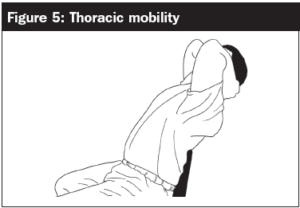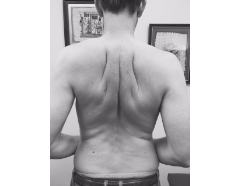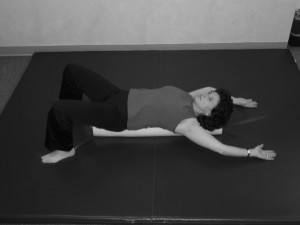A very important piece of our skeleton’s kinetic chain is the thoracic spine and ribs. This area serves the important task of protecting our vital organs and fragile lungs and heart from outside forces. Given these important tasks and, that many of us sit hunched over at our desks all day; we can understand why it would be subject to immobility right? Well, it so happens that our thoracic complex functions best when it can move and guess what? So does the rest of the chain above and below!
Below are important reasons why it’s important for our thoracic spines to be mobile?
- When you take a breath, an efficient rib cage expands in every direction (think balloons filling with air). Muscles between every rib contract and relax to allow for maximum inhalation or oxygen intake. Lack of rib mobility leads to inefficient breathing so we tire more quickly.
- One of the most obvious instances of thoracic stiffness is the typical loss of extension (aka – forward bent postures or hunch back postures). Gravity is always pulling us downward. Life is lived mostly through our eyes and hands so we have little incentive to stretch regularly into backward bends. We bend forward for lifting, looking down, reaching, cleaning, driving, eating and computer work to name a few. Thus over time, many of us lose ability to attain a neutral spine. A forward bent thoracic spine and rib cage compresses the internal organs that it’s supposed to be protecting thereby making it, among other things, more difficult to breathe.
- If the thoracic spine is forward bent with an increased kyphosis, it’s difficult to stand erect. It won’t stop us from trying to stand tall but the movement will have to come from elsewhere. That is often the low back. Excessively extending the lumbar or standing sway back can make a person feel they are more upright but this usually leads to more physical impairments.
- If your thoracic spine can’t rotate, the low back has to do more than it’s share of twisting. This might mean more ache after a golf game or the random twinge of back pain while backing up the car.
- A great test of thoracic influence on the neck movement is this: In sitting, sit in your worst posture. Turn your head as far as you can. Without turning your head back neutral, correct your posture and try to turn your head further. Usually there is another 10-20 degrees of movement once your posture is correct. Throughout your day, cervical spine mobility as well as its stability are heavily affected by what’s happening below!
- The same test could be done with the shoulders. Slump and try reaching for the ceiling. Keep reaching as you correct posture. All ranges of shoulder movement are restricted when thoracic mobility is limited. Of course in addition to stiffness, pain is also a symptom of restricted mobility.
- Much of our strength and stability (spine and extremities) lies in our ability to obtain a neutral spine. We are most powerful when we can find neutral!
I’m sure there are many more ways that thoracic mobility is important to the skeletal system but I think you get the idea. A kink in body’s kinetic chain functions much like a ripple effect. It is often unclear where the first kink began because so many compensations evolve over weeks and months of activity.
The best way to keep the T-spine as well as the rest of your body mobile is to move it! A great thoracic mobility exercise is a chair-back stretch as shown below. Of course there are more aggressive techniques such as lying on a high density foam roller. There are also more gentle stretches such as shoulder blade squeezes. Keep you thoracic spine healthy by consistently watching your posture and perform regular thoracic exercises! For help with this ask your physical therapist or personal trainer for an explanation of exercises.
Thank you to Shawn Babcock at Mountain Physical Therapy for contributing this article to our newsletter.
Chair Back Extension

Shoulder Blade Squeezes

Foam Roller – Snow Angels
